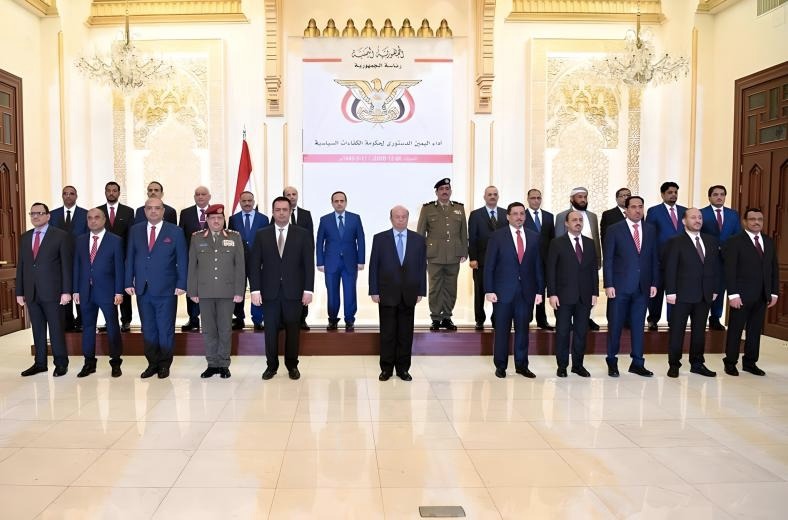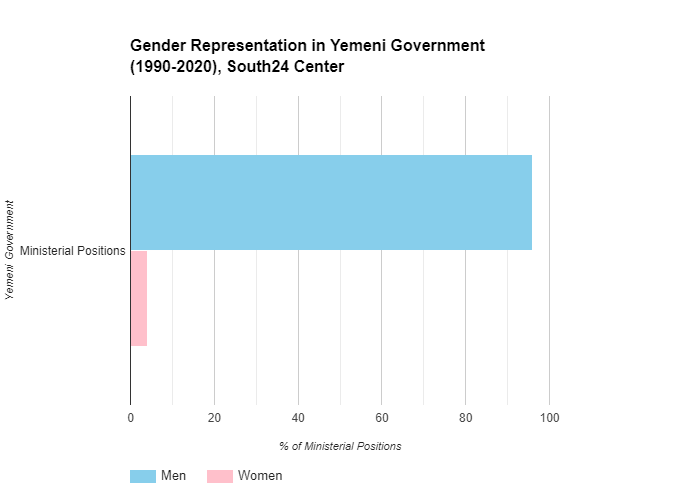
A photo of the Yemeni government, formed in December 2020, improved using artificial intelligence (Source: South24 Center)
Last updated on: 20-03-2024 at 5 PM Aden Time

The political participation of both male and female citizens in democratic societies is the most prominent feature distinguishing them from authoritarian regimes.
Bilqees Al Abdaly (South24)
The year 2020 marked a dangerous turning point for female political participation in Yemen, when Maeen Abdulmalik was appointed as the Head of the government consisting of 24 ministers, equally divided between representatives from North and South. It had representation for all traditional political entities in addition to new Southern bodies, such as the Southern Transitional Council (STC). This came after more than one year of negotiations sponsored by Saudi mediators based on the Riyadh Agreement, signed on November 5, 2019. [1] Despite this North – South representation, it was the first Yemeni government in 30 years to have zero female representation, despite women constituting almost 50% of the Yemeni population.
The decline of female participation
Since the establishment of unity between the North and South in 1990, until 2020, the total number of ministerial portfolios was 444, 95.9% of which were allocated to men. The number of ministerial portfolios allocated to women over those 30 years was just 18, or 4.1% of the total, and the last government to have had female representation was in 2016. This clearly demonstrates the ongoing marginalization of women in the consecutive Yemeni governments. [2]
According to a report published by the news website ‘Manasati 30’, 11 women participated in seven consecutive governments in Yemen. They include four female ministers who kept their positions through at least two governments.
Female representation was limited to the ministries of Human Rights & Social Affairs, and Labour. Later, a decisive breakthrough occurred within the technocratic government in 2014, when women gained roles in the ministries of Media, and Culture. The Legal Affairs Ministry also welcomed women during the term of the Bin Dagher Government in 2016. The aforementioned technocratic government, chaired by Khaled Bahah at the end of 2014, witnessed the largest female representation out of the 30 years since 1990, with women making up 11.7% of it.

However, this representation hasn’t met the expectations of women who hoped to achieve the 30% female quota stipulated in the outputs of the ‘National Dialogue Conference’ in 2013. Nonetheless, those limited gains faded away after the appointment of the 2020 Yemeni government, which featured no female representation. [3]
Challenges
Representation of Yemeni women in the National Dialogue Conference was more than 27%, a much-deserved entitlement following several years of struggle. Women also had remarkable representation in the ‘Popular Movement’ of 2011. All these efforts were rewarded with the approval of the 30% quota system, as part of the outputs of the 2013 National Dialogue Conference. 50 of the conference’s articles explicitly stipulated the rights of women and of their political participation. [4] One of the most prominent of these articles by the State Building Team was the decision to adopt the ‘closed relative list’ as the electoral system of the country. It is a list prepared by ‘A Friend of Women’, a female rights group made up of both male and female activists. This enables women to reach elections and join elected bodies without having to engage in unilateral confrontations against male nominees. This is a rather difficult task in a traditional tribal society such as Yemen.
Another decision by the State Building Team stipulated that “women should represent at least 30% of the elected legislative councils. The law guarantees achieving this percentage”. The decision was met with strong opposition by some of the more traditional forces. According to a report on the female quota, “120 religious scholars in Yemen, from different orientations, issued a fatwa that prohibits the female quota, describing it as a foreign demand adopted by some women who are linked to embassies and backed by foreign organizations”. [5]
The battles on the ground have deprived women of the gains made since 2011. They have impacted female involvement in movements to raise awareness, or to engage in dialogues with all forces that oppose the quota system or the closed relative list. Although the conflict among different parties hasn't stopped their movement and struggle to achieve their right to effective participation during the ongoing decade-long war, it has led, on the other hand, to the deterioration of political work, freezing the activities of political parties and the decline of their impact at the public affairs level. This has negatively impacted the margin of female political participation in Yemen represented by the activities of partisan women.
Mobilizing women as voters turned out to be easier and less controversial in the pre-war period than integrating women into leadership and decision-making roles within the parties [6] during the period before the outbreak of the latest civil war. For example, the number of female nominees in the 2006 local elections was only 168, out of a total of 19223 nominees competing for about 6000 seats. Female political activists expressed their anger during a political demonstration before closing the nomination door.
Moreover, statistics show that the number of women who have leading positions in the Yemeni parties is 259, or 2%, of a total of 12975. This percentage doesn’t realistically reflect the proportion of women within society or inside the parties themselves. While articles 24, 30, 31, 41 and 43 [7] of the Yemeni Constitution stipulate equality and equal rights for both men and women, they don’t present a positive distinction that helps women obtain their right to political participation. Furthermore, the General Elections and Referendum Law No.13 of 2001 is only interested in women’s role as voters. The ‘individual district system’ used for elections in Yemen reduces female opportunities, regardless of their qualifications. This limitation is exacerbated by the tendency of their rival male nominees being influential and powerful.
Women and civil values
The political participation of both male and female citizens in democratic societies is the most prominent feature that distinguishes them from authoritarian regimes, in which a certain categorical group seizes and monopolizes power. Female political participation in a country such as Yemen, which is undergoing significant political transformations, is one of the most important mechanisms for building a working future democracy. It serves as a litmus test for gauging the commitment of elites and political parties to the principles of equality, citizenship, and the rule of law. Thus, laying the groundwork for this participation is imperative, particularly during the initial phases of peacebuilding efforts.
It is crucial to emphasize that any involvement of Yemeni women in public affairs, political activities, or advocacy efforts, does not replace their official representation in the government, which enables them to shape policies and implement decisions aligned with their visions for political processes as a whole. This extends to fostering increased female participation and enhancing their roles at both local and national levels. Such measures can constitutionalize women’s rights in the future and advocate for legislation that supports their meaningful participation. The presence of women at the top of the government hierarchy could also bridge the divide between the traditional power structures and female empowerment. This would create a space for joint action and establish female-centric models that challenge the dominating community vision of women, by emulating their roles and supporting them as female leader role-models, free from accusations of deviating from the traditional Yemeni value system or of subordination to any external agendas.
1- Tariq Al-Dhalimi, The Yemeni Woman.. The Deleted Margin of the Parity Government (hodaj.net Arabic)
2- Hamdy Rassan, In Yemen.. Governments without Women (Manasati30 Arabic)
3- Tariq Al-Dhalimi, The Yemeni Woman.. The Deleted Margin of the Parity Government (hodaj.net Arabic)
4- Bin Mubarak: More than 50 articles of the outputs of the National Dialogue stipulate female rights. They are inputs to the constitution drafting process. (National Information Center Arabic)
5- Marib Al-Ward, The Female Quota Occupies the Attention of Yemen (Al-Jazeera.Net Arabic)
6- Rim Mugahed and Stacey Philbrick Yadav, “‘One Hand Doesn't Clap’: Partisanship and the Dual Challenge of Women’s Inclusion in Yemen (The Sana’a Center for Strategic Studies).
7- The Yemeni Constitution